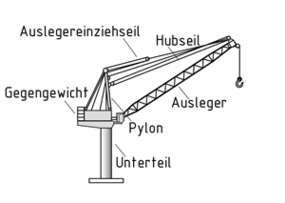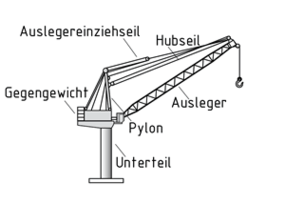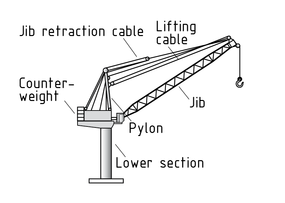
Choose one
or multiple languages
0,1,1
- German
- English
- Chinese
- Spanish
Luffing gear

Luffing gear is used to change the angle of incline of a jib (e.g. of a crane) and thus its reach. Compared to derricking gear, luffing Gear is faster, although the primary source of loading for both - as in the case of Lifting gear - is weight, i.e. the combined weight of the object being lifted and the dead weight of the jib.
Cable, rack-and-pinion, hydraulic and spindle drives are used in luffing gear to raise and lower the jib. The guidance systems for the jib and lifting cable are designed so that the trajectory of the load stays as horizontal as possible as the reach of the jib changes (vertical travel compensation). The mass of the jib is largely offset by counterweights on the jib, cable or rocker arm or parallelogram connecting rods.
Cable pulleys, block and tackle systems, cable rigging, double link designs and horse-head jibs are used to compensate for vertical travel.
Wippwerke

Mit Wippwerken werden der Neigungswinkel eines Auslegers (beispielsweise bei Kranen) und damit seine Ausladung verändert. Im Gegensatz zu Einziehwerken arbeiten Wippwerke mit höherer Geschwindigkeit. Ähnlich wie Hubwerke werden beide vor allem durch Gewichtskräfte beansprucht. Dabei addieren sich Hubmasse und Eigenmasse des Auslegers.
Zum Heben und Senken des Auslegers werden im Wippwerk Seil-, Zahnstangen-, Hydraulik- oder Spindelantriebe eingesetzt. Die Ausleger- und Hubseilführung wird so gestaltet, dass sich die Last bei Veränderungen der Ausladung möglichst auf horizontalen Bahnen bewegt (Hubwegausgleich). Die Eigenmasse des Auslegers wird durch Gegenmassen an Ausleger, Seil oder Schwinghebel oder durch Parallelogramm-Lenker weitgehend ausgeglichen.
Um den Hubwegausgleich zu erreichen, werden Seilrollen- und Flaschenzüge, Einscherungen des Hubseils, Kurvenlenker oder Doppellenker eingesetzt.
变幅机构

变幅机构 通过改变吊臂倾斜角度(比如起重机的)从而达到变幅目的。尽管对于提升机构而言,最主要的负载其实是自重,比如起吊物体和吊臂的重量,但是相比于别的变幅机构 (Derricking Gear),此变幅机构速度更快。
变幅机构通过缆索、齿轮齿条、液压部件和主轴驱动来升降吊臂。经过特殊设计的吊臂导引系统和升降索,通过不断改变吊臂作业范围( 垂直行程补偿),确保负载可以在尽可能水平的轨迹上运行。吊臂的质量很大程度上被吊臂的配置,缆索,摇臂和平行四边形连杆的质量抵消了。
缆索滑轮,滑轮系统,缆索传动装置,双连杆设计和马头型吊臂综合作用,补偿垂直行程。
变幅回转起重机
近义词
变幅机构
垂直行程补偿
Equipo de abatimiento

El equipo de abatimiento se usa para cambiar el ángulo de inclinación de un brazo (por ejemplo, de una grúa) y por lo tanto su alcance. Comparado con el equipo de accionamiento de grúa, el equipo de abatimiento es más rápido, aunque la fuente primaria de carga para ambos, como en el caso del equipo de elevación, es el peso, es decir, el peso combinado del objeto que se eleva y el peso muerto del brazo.
Las transmisiones de cable, piñón y cremallera, hidráulicas y de husillo se usan en el equipo de abatimiento para elevar y bajar el brazo. Los sistemas guía para el brazo y el cable de elevación están diseñados de manera que la trayectoria de la carga permanezca lo más horizontal posible al cambiar el alcance del brazo (compensación de viaje vertical). La masa del brazo es compensada principalmente por contrapesos en el brazo, un cable o balancín, o varillas de conexión de paralelogramo.
Las poleas de cable, los sistemas de aparejos de poleas, aparejos de cable, diseños de doble eslabón y brazos cabeza de caballo se usan para compensar el desplazamiento vertical.
Pluma y orzado
